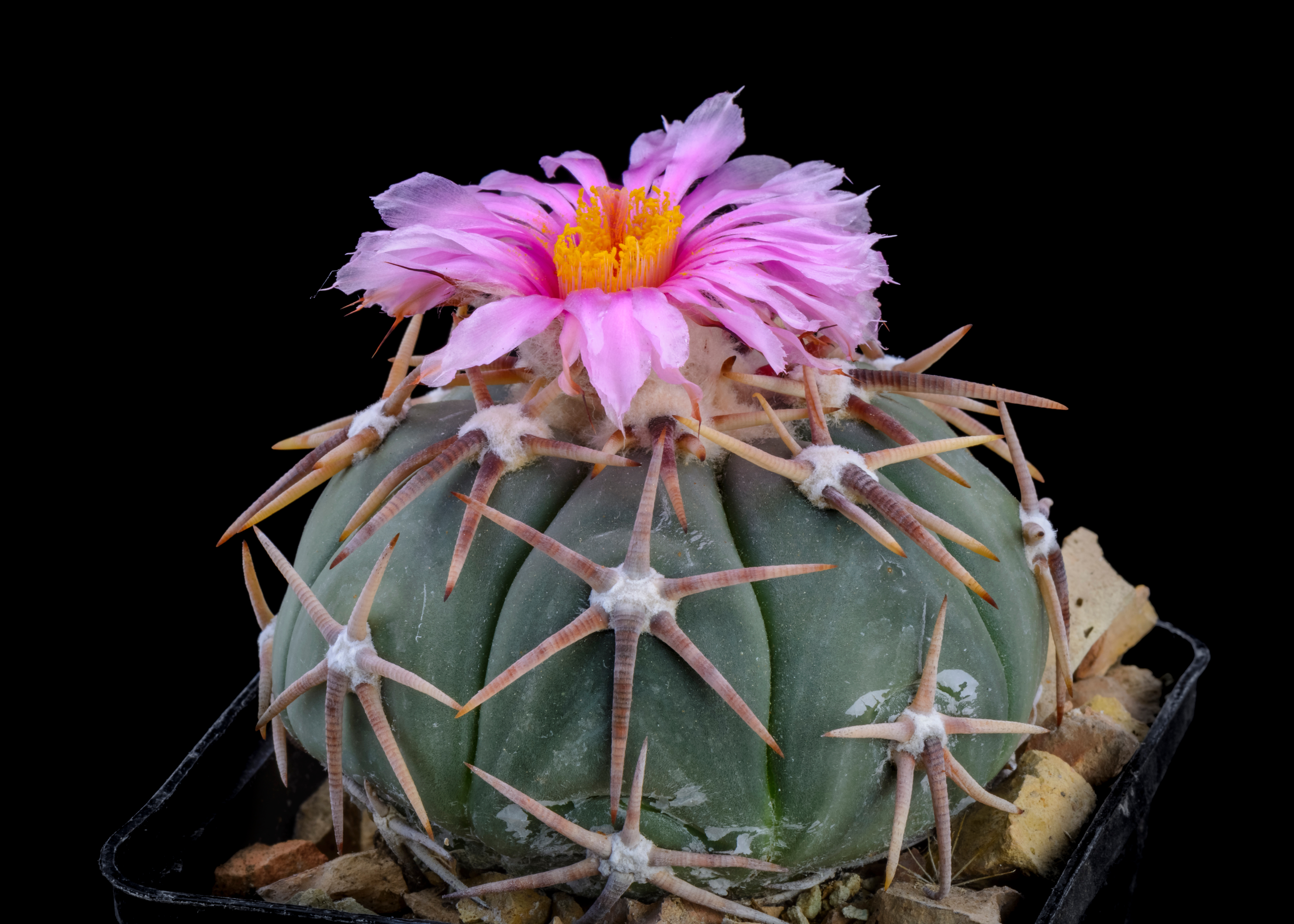Eagle's claw cactus
(Echinocactus horizonthalonius)

Description
Echinocactus horizonthalonius, commonly known as the eagle's claw cactus or horse crippler, is a species of cactus native to the Chihuahuan Desert of Mexico and the United States. This slow-growing cactus can reach up to 40 cm in height and 30 cm in diameter, with a globular or cylindrical shape. It is a popular ornamental plant due to its striking appearance, and it is often used in xeriscaping and rock gardens. Taxonomy and Etymology Echinocactus horizonthalonius belongs to the family Cactaceae, which is comprised of over 2,000 species of succulent plants. It was first described by the botanist Heinrich Hildmann in 1900 and was later reclassified as Ferocactus horizonthalonius by Britton and Rose in 1922. However, it was eventually returned to the Echinocactus genus, and its current accepted name is Echinocactus horizonthalonius. The genus name "Echinocactus" is derived from the Greek words "echinos" meaning "hedgehog" and "kaktos" meaning "thistle." This name refers to the plant's spiky appearance. The species epithet "horizonthalonius" is derived from the Latin words "horizon" meaning "boundary" and "thallo" meaning "shoot." This name refers to the cactus's habit of growing on rocky hillsides and other harsh environments. Distribution and Habitat Echinocactus horizonthalonius is native to the Chihuahuan Desert of Mexico and the southwestern United States. Its range extends from southeastern Arizona and southwestern New Mexico to northern Mexico, including the states of Chihuahua, Coahuila, Durango, and Zacatecas. It is often found growing in rocky hillsides, canyons, and other arid environments. The plant prefers well-draining soil and full sun and is tolerant of drought and heat. Description Echinocactus horizonthalonius is a slow-growing cactus that can reach up to 40 cm in height and 30 cm in diameter. Its globular or cylindrical shape is composed of numerous ribs that are covered in sharp, pointed spines. These spines can range in color from white to yellow to reddish-brown and can grow up to 5 cm in length. The cactus produces large, yellow flowers that can measure up to 7 cm in diameter. These flowers typically bloom in late spring or early summer and are followed by small, edible fruits that contain numerous seeds. Cultivation Echinocactus horizonthalonius is a hardy plant that is relatively easy to cultivate. It requires full sun and well-draining soil, and it is tolerant of drought and heat. The plant should be watered sparingly during the growing season, and the soil should be allowed to dry out completely between waterings. In the winter months, the plant should be kept dry and protected from frost. Propagation can be achieved through seed or cuttings. Seeds should be sown in well-draining soil in the spring, and cuttings should be taken in the summer and allowed to callus over before being planted. Echinocactus horizonthalonius can be grown as an ornamental plant in xeriscaping and rock gardens. Uses Echinocactus horizonthalonius is primarily used as an ornamental plant in xeriscaping and rock gardens. Its striking appearance and low-maintenance requirements make it a popular choice for landscaping in arid environments. In addition, the cactus's fruits are edible and have been used by indigenous peoples as a food source. However, it should be noted that the plant should only be consumed by those with proper knowledge of its preparation and potential risks. Overall, the plant is mainly valued for its ornamental qualities and ability to thrive in challenging growing conditions. Conservation Status Echinocactus horizonthalonius is not currently listed as a threatened species. However, like many desert plants, it is threatened by habitat loss and illegal collection. In some areas, the plant has also been impacted by the construction of roads, power lines, and other infrastructure projects. It is important to protect the natural habitats of this plant to ensure its continued survival in the wild. In addition to habitat conservation, efforts are being made to cultivate Echinocactus horizonthalonius in cultivation to reduce the pressure on wild populations. This can help to ensure the availability of the plant for ornamental and other uses without having to remove plants from the wild. Conclusion Echinocactus horizonthalonius is a fascinating and unique cactus species that is prized for its striking appearance and low maintenance requirements. As a slow-growing plant that thrives in arid environments, it is an excellent choice for xeriscaping and rock gardens. However, it is important to protect the natural habitats of this plant to ensure its continued survival in the wild. By cultivating the plant in cultivation and promoting its conservation, we can ensure that this remarkable species remains a part of our natural heritage for generations to come.
Taxonomic tree:







